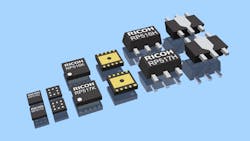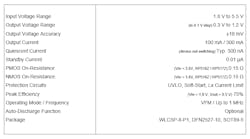VFM Mode Buck DC-DC Converters Target Wearables and IoT Devices
Ricoh Electronic Devices Co. Ltd. has launched two buck dc-dc converters, the RP516 and RP517, designed for use in wearable devices and Internet of Things (IoT) applications requiring advanced solutions for extending battery life, as well as reduced mounting area and weight on high-density boards.
Today’s wearable and IoT devices mainly operate in sleep mode; thus, quiescent current becomes a critical factor in power consumption. In this mode, the system is idle but ready to wake up any time to perform a task, transmitting some data, before resuming sleep mode again.
The RP516 and RP517 are optimized to prolong battery life, and designed for applications that require a low supply voltage between 0.3 and 1.2 V. According to Ricoh, this kind of power supply is tailored to support the newest generation of low-power MCUs, GPS/GNSS receiver/processors, and other ICs required in IoT applications for low-power wireless sensor networks and wearable devices.
The dc-dc converters operate in VFM mode, with the efficiency at light loads peaking at 75%. Even at 0.01-mA output current, an efficiency performance of about 67% is achieved (conditions: Vout = 0.5 V, Vin = 1.8 V), claims the company.
A quiescent current of 300 nA contributes to extending battery life, or makes it possible for the designer to select a smaller-sized battery for the application. The main difference between the two products is their output current power—they deliver 100 and 300 mA, respectively. The company says both products offer synchronous rectification, and integrate high- and low-side MOSFET driver transistors. Three different packages are available: a standard SOT-89-5, a leadless DFN2527-10, or the most compact WLCSP-8-P1 package. By using the proposed external components, it takes up 8.3 mm2 of PCB area. Owing to the wide input voltage range, the two dc-dc converters are able to operate from various power supplies like a USB port, a single cell Li-ion, and other regular batteries.
Protection circuits are integrated—an undervoltage-lockout (UVLO) circuit disables the dc-dc converter in case the input voltage drops below a minimum threshold. A soft-start circuit controls the output voltage to ramp up smoothly, preventing any output overshoot and undershoot during the startup period. The Lx current limit circuit prevents the peak current through the inductor from exceeding a specific maximum current threshold.
The RP516 and RP517 have an optional auto-discharge function that rapidly discharges the output capacitor once the CE pin disables the chip.
Features of the RP516 / RP517:


